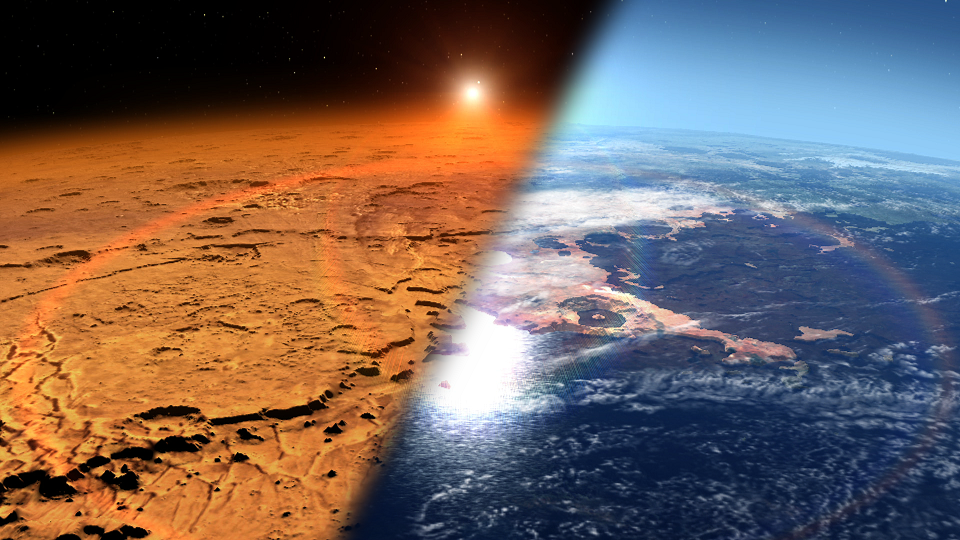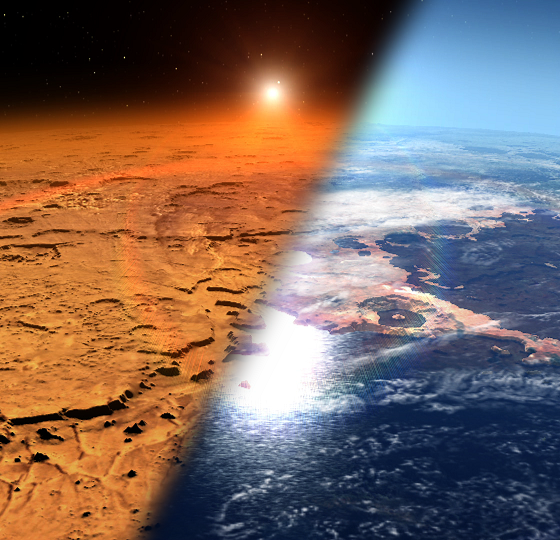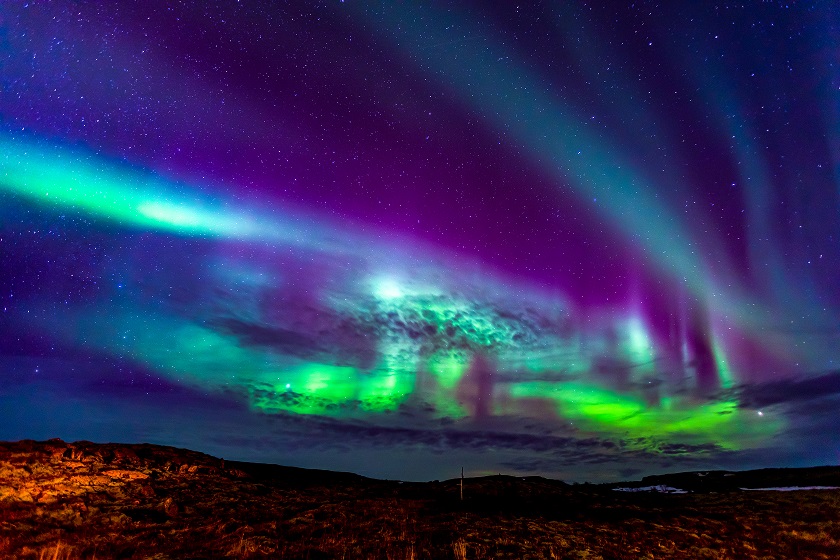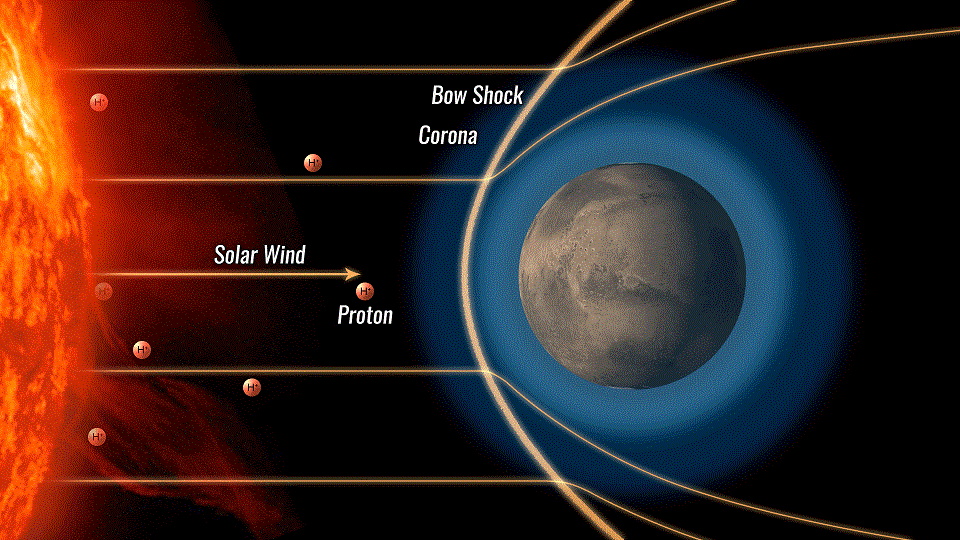

News
Martian auroras offer clues to how the red planet lost its water
Aurorae are a dazzling light spectacle often visible at high-latitude locations here on Earth. They’re colorful and mesmerizing, but most of all, they’re mysterious.
A new study has found that this same phenomenon also happens on Mars. In research presented last week at the American Geophysical Union’s annual Fall meeting, scientists revealed that the most common form of Martian aurorae is called the proton aurora.
Just like the auroras we see here on Earth, proton aurorae are formed when the solar wind—a stream of charged particles emanating from the Sun—interacts with the atmosphere. That interaction often manifests itself as a mesmerizing swirl of colored lights in the night sky.
On Mars, however, the auroras appear during the daytime and onlookers would need special ultraviolet glasses to see them. That’s because they’re invisible to the naked eye, but can be spotted with special UV instruments.

These auroras aren’t just a future Martian tourist attraction, they have a scientific value. We could better understand how Mars is losing water to space and more about how the planet’s climate is changing.
Proton auroras were first discovered in 2016 by NASA’s Mars Atmosphere and Volatile Evolution (MAVEN) spacecraft. MAVEN is investigating how the Red Planet lost its atmosphere and water, ultimately transforming its climate from one that may have supported life to one that is inhospitable.
The observed aurora can help researchers track the amount of water lost since the auroras are related to water loss.
“In this new study using MAVEN/IUVS data from multiple Mars years, the team has found that periods of increased atmospheric escape correspond with increases in proton aurora occurrence and intensity,” Andréa Hughes of Embry-Riddle Aeronautical University in Daytona Beach, Florida said in a news release.
Auroras on both planets start with the same source: the solar wind. On Earth, they appear when the solar wind slams into our planet’s magnetic field. High-energy collisions occur as the charged solar particles interact with particles of atmospheric gas. Each type of particle produces a different colored light in the sky.
Martian auroras start in much the same way, charged particles from the solar wind collide with a cloud of hydrogen that surrounds the red planet. When this happens, protons in the solar wind become neutral after stealing electrons from the hydrogen atoms. They then collide with other molecules in the Martian atmosphere, producing an ultraviolet glow.

Since the hydrogen cloud surrounding the planet is created in part by water being lost to space, this could give scientists a way to measure the amount of water lost over time.
When the MAVEN team first observed the proton aurora, they thought they were witnessing an unusual phenomenon. “At first, we believed that these events were rather rare because we weren’t looking at the right times and places,” Mike Chaffin, a research scientist at the University of Colorado Boulder’s Laboratory for Atmospheric and Space Physics (LASP) said in a statement.
After Chaffin’s team took a closer look, they discovered that the proton auroras occur quite frequently, especially in the summer. This is probably due to seasonal variation in the hydrogen cloud that surrounds Mars. The team noted that during the Martian summer, the cloud lines up just right to produce near-constant auroras.
But that’s not all. The researchers also discovered that as temperatures climb during the summer, rising dust clouds would carry water vapor away from the planet’s surface. That water vapor is then broken down into its components: hydrogen and oxygen. As more hydrogen escapes into space, it enhances the hydrogen cloud enveloping Mars and ultimately leads to more frequent (and brighter) proton auroras.

“Observations of proton auroras at Mars provides a unique perspective of hydrogen and, therefore, water loss from the planet,” physicist Edwin Mierkiewicz of Embry-Riddle Aeronautical University in Florida said in a statement.
“Through this research, we can gain a deeper understanding of the Sun’s interactions with the upper atmosphere of Mars and with similar bodies in our Solar System, or in another solar system, that lacks a global magnetic field.”
So, if we ever do make it to Mars, those first visitors are going to witness some truly out-of-this-world sights—as long as they packed their ultraviolet goggles.

News
Tesla aims to combat common Full Self-Driving problem with new patent
Tesla writes in the patent that its autonomous and semi-autonomous vehicles are heavily reliant on camera systems to navigate and interact with their environment.

Tesla is aiming to combat a common Full Self-Driving problem with a new patent.
One issue with Tesla’s vision-based approach is that sunlight glare can become a troublesome element of everyday travel. Full Self-Driving is certainly an amazing technology, but there are still things Tesla is aiming to figure out with its development.
Unfortunately, it is extremely difficult to get around this issue, and even humans need ways to combat it when they’re driving, as we commonly use sunglasses or sun visors to give us better visibility.
Cameras obviously do not have these ways to fight sunglare, but a new patent Tesla recently had published aims to fight this through a “glare shield.”
Tesla writes in the patent that its autonomous and semi-autonomous vehicles are heavily reliant on camera systems to navigate and interact with their environment.

The ability to see surroundings is crucial for accurate performance, and glare is one element of interference that has yet to be confronted.
Tesla described the patent, which will utilize “a textured surface composed of an array of micro-cones, or cone-shaped formations, which serve to scatter incident light in various directions, thereby reducing glare and improving camera vision.”

The patent was first spotted by Not a Tesla App.
The design of the micro-cones is the first element of the puzzle to fight the excess glare. The patent says they are “optimized in size, angle, and orientation to minimize Total Hemispherical Reflectance (THR) and reflection penalty, enhancing the camera’s ability to accurately interpret visual data.”
Additionally, there is an electromechanical system for dynamic orientation adjustment, which will allow the micro-cones to move based on the angle of external light sources.
This is not the only thing Tesla is mulling to resolve issues with sunlight glare, as it has also worked on two other ways to combat the problem. One thing the company has discussed is a direct photon count.
CEO Elon Musk said during the Q2 Earnings Call:
“We use an approach which is direct photon count. When you see a processed image, so the image that goes from the sort of photon counter — the silicon photon counter — that then goes through a digital signal processor or image signal processor, that’s normally what happens. And then the image that you see looks all washed out, because if you point the camera at the sun, the post-processing of the photon counting washes things out.”
Future Hardware iterations, like Hardware 5 and Hardware 6, could also integrate better solutions for the sunglare issue, such as neutral density filters or heated lenses, aiming to solve glare more effectively.
Elon Musk
Delaware Supreme Court reinstates Elon Musk’s 2018 Tesla CEO pay package
The unanimous decision criticized the prior total rescission as “improper and inequitable,” arguing that it left Musk uncompensated for six years of transformative leadership at Tesla.

The Delaware Supreme Court has overturned a lower court ruling, reinstating Elon Musk’s 2018 compensation package originally valued at $56 billion but now worth approximately $139 billion due to Tesla’s soaring stock price.
The unanimous decision criticized the prior total rescission as “improper and inequitable,” arguing that it left Musk uncompensated for six years of transformative leadership at Tesla. Musk quickly celebrated the outcome on X, stating that he felt “vindicated.” He also shared his gratitude to TSLA shareholders.
Delaware Supreme Court makes a decision
In a 49-page ruling Friday, the Delaware Supreme Court reversed Chancellor Kathaleen McCormick’s 2024 decision that voided the 2018 package over alleged board conflicts and inadequate shareholder disclosures. The high court acknowledged varying views on liability but agreed rescission was excessive, stating it “leaves Musk uncompensated for his time and efforts over a period of six years.”
The 2018 plan granted Musk options on about 304 million shares upon hitting aggressive milestones, all of which were achieved ahead of time. Shareholders overwhelmingly approved it initially in 2018 and ratified it once again in 2024 after the Delaware lower court struck it down. The case against Musk’s 2018 pay package was filed by plaintiff Richard Tornetta, who held just nine shares when the compensation plan was approved.
A hard-fought victory
As noted in a Reuters report, Tesla’s win avoids a potential $26 billion earnings hit from replacing the award at current prices. Tesla, now Texas-incorporated, had hedged with interim plans, including a November 2025 shareholder-approved package potentially worth $878 billion tied to Robotaxi and Optimus goals and other extremely aggressive operational milestones.
The saga surrounding Elon Musk’s 2018 pay package ultimately damaged Delaware’s corporate appeal, prompting a number of high-profile firms, such as Dropbox, Roblox, Trade Desk, and Coinbase, to follow Tesla’s exodus out of the state. What added more fuel to the issue was the fact that Tornetta’s legal team, following the lower court’s 2024 decision, demanded a fee request of more than $5.1 billion worth of TSLA stock, which was equal to an hourly rate of over $200,000.
Delaware Supreme Court Elon Musk 2018 Pay Package by Simon Alvarez
News
Tesla Cybercab tests are going on overdrive with production-ready units
Tesla is ramping its real-world tests of the Cybercab, with multiple sightings of the vehicle being reported across social media this week.

Tesla is ramping its real-world tests of the Cybercab, with multiple sightings of the autonomous two-seater being reported across social media this week. Based on videos of the vehicle that have been shared online, it appears that Cybercab tests are underway across multiple states.
Recent Cybercab sightings
Reports of Cybercab tests have ramped this week, with a vehicle that looked like a production-ready prototype being spotted at Apple’s Visitor Center in California. The vehicle in this sighting was interesting as it was equipped with a steering wheel. The vehicle also featured some changes to the design of its brake lights.
The Cybercab was also filmed testing at the Fremont factory’s test track, which also seemed to involve a vehicle that looked production-ready. This also seemed to be the case for a Cybercab that was spotted in Austin, Texas, which happened to be undergoing real-world tests. Overall, these sightings suggest that Cybercab testing is fully underway, and the vehicle is really moving towards production.
Production design all but finalized?
Recently, a near-production-ready Cybercab was showcased at Tesla’s Santana Row showroom in San Jose. The vehicle was equipped with frameless windows, dual windshield wipers, powered butterfly door struts, an extended front splitter, an updated lightbar, new wheel covers, and a license plate bracket. Interior updates include redesigned dash/door panels, refined seats with center cupholders, updated carpet, and what appeared to be improved legroom.
There seems to be a pretty good chance that the Cybercab’s design has been all but finalized, at least considering Elon Musk’s comments at the 2025 Annual Shareholder Meeting. During the event, Musk confirmed that the vehicle will enter production around April 2026, and its production targets will be quite ambitious.








